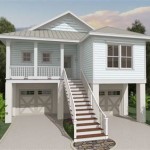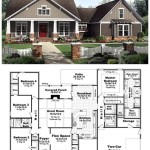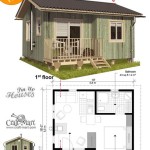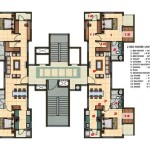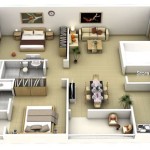Floor Plan Of A House
A floor plan is a detailed drawing that shows the layout of a building, including the arrangement of rooms and spaces. It is an essential tool for architects and builders, as it allows them to visualize and plan the space before construction begins. Floor plans can also be used by homeowners to help them understand the layout of their home and make decisions about renovations or additions.
There are many different types of floor plans, depending on the size and complexity of the building. Simple floor plans may only show the basic layout of the rooms, while more complex floor plans may include detailed information about the location of windows, doors, and other features. Floor plans can also be used to show the flow of traffic through a building, and to identify potential problem areas.
When creating a floor plan, architects and builders will typically start by sketching out the basic layout of the building. They will then add details such as windows, doors, and other features. Once the floor plan is complete, it will be used to create a building permit and to guide the construction process.
Floor plans are an important tool for architects, builders, and homeowners. They provide a visual representation of the layout of a building, and can be used to plan construction, make decisions about renovations, and understand the flow of traffic through a space.
Elements Of A Floor Plan
Floor plans typically include the following elements:
- Walls: Walls are shown as lines on a floor plan. They can be solid or dashed, and they can represent different types of walls, such as interior walls, exterior walls, and load-bearing walls.
- Doors: Doors are shown as small rectangles on a floor plan. They can be open or closed, and they can represent different types of doors, such as entry doors, interior doors, and sliding doors.
- Windows: Windows are shown as small squares or rectangles on a floor plan. They can be open or closed, and they can represent different types of windows, such as casement windows, awning windows, and picture windows.
- Stairs: Stairs are shown as a series of small lines on a floor plan. They can represent different types of stairs, such as straight stairs, curved stairs, and spiral stairs.
- Furniture: Furniture is sometimes shown on a floor plan to help visualize the layout of a space. It can represent different types of furniture, such as beds, sofas, and tables.
- Dimensions: Dimensions are often included on a floor plan to show the size of the rooms and spaces. They can be shown in feet, inches, or meters.
Types Of Floor Plans
There are many different types of floor plans, depending on the size and complexity of the building. Some of the most common types of floor plans include:
- Single-story floor plans: Single-story floor plans show the layout of a building with one level. They are typically used for small homes, cabins, and other simple structures.
- Multi-story floor plans: Multi-story floor plans show the layout of a building with multiple levels. They are typically used for larger homes, apartment buildings, and commercial buildings.
- Open floor plans: Open floor plans have a large, open space with few walls or partitions. They are typically used for modern homes and apartments.
- Closed floor plans: Closed floor plans have a more traditional layout, with separate rooms for different functions. They are typically used for older homes and apartments.
- Custom floor plans: Custom floor plans are designed to meet the specific needs of a client. They can be any size or shape, and they can include any features that the client desires.
How To Read A Floor Plan
Reading a floor plan can be challenging at first, but with a little practice, it will become easier. Here are a few tips for reading a floor plan:
- Start by identifying the walls. Walls are typically shown as lines on a floor plan. They can be solid or dashed, and they can represent different types of walls, such as interior walls, exterior walls, and load-bearing walls.
- Next, identify the doors and windows. Doors are shown as small rectangles on a floor plan, and windows are shown as small squares or rectangles. They can be open or closed, and they can represent different types of doors and windows.
- Finally, identify the stairs. Stairs are shown as a series of small lines on a floor plan. They can represent different types of stairs, such as straight stairs, curved stairs, and spiral stairs.
Once you have identified the basic elements of a floor plan, you can start to understand the layout of the building. Pay attention to the dimensions of the rooms and spaces, and the location of the doors, windows, and stairs. This will help you to visualize the flow of traffic through the building, and to make decisions about renovations or additions.

House Plans How To Design Your Home Plan

House Plans How To Design Your Home Plan

House Plans How To Design Your Home Plan

Small House Plan Ideas For Diffe Area To See More Read It Floor Plans

Floor Plans Types Symbols Examples

Small House Design 2024001 Pinoy Eplans Floor Plans

How To Read A Floor Plan With Dimensions Houseplans Blog Com

Peach Tree House Plan Ranch Floor Designs

Typical Floor Plan Small Apartment Building House Plans Residential

Floor Plan Creator And Designer Free Easy App

